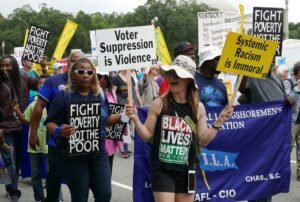
Yesterday marked the last mass for parishioners of St. John Vianney Roman Catholic Church in southwestern Pennsylvania. Bishop David Zubik, head of the Catholic Diocese of Pittsburgh, determined that the church would close, as its debt had climbed above $3 million while the number of parishioners has steadily declined. Three other parishes in the area will absorb the membership of St. John Vianney. The St. George Church Preservation Society, which formed in August after the announcement was made that a closure was possible, is hoping to reverse this decision. So far, the group has gained more than $70,000 in commitments against the proposed $600,000 in renovations necessary. St. John Vianney originally opened as St. George Church at the turn of the last century.
Closures of Catholic churches have grown commonplace in the Northeast and Midwest but the closures do not always go unprotested. Parishioners who have been baptized and confirmed and married in a parish, who have raised sometimes massive amounts of money to maintain and improve buildings and help manage the operations as an important part of their community life, understandably feel a sense of ownership and violation when the church decides to eliminate a parish. NPQ has been following for more than a decade the parishioners’ occupation of St. Frances X. Cabrini church in the small New England town of Scituate as they argued with the Boston Archdiocese about the fate of their parish which sits on a valuable piece of land. The parishioners have pursued the case in court, and last month petitioned the Supreme Court to back their case, which is based on the church being their property according to church law. They will hear imminently about whether the case will be heard.
This dynamic in the Catholic Church is not alone in the nonprofit sector. Over the past decade, NPQ has documented the sometimes forced consolidation of various networks, including the Girl Scouts, the Red Cross, the March of Dimes, and the Alzheimer’s Association, and the pushback from constituents who believe that these entities that they have spent so much time and effort and money building are, in part, theirs. In the case of the Alzheimer’s Association, for instance, a number of chapters have disaffiliated and are reportedly facing aggressive competition from what used to be home base.
For the central organizations, the question may seem cut and dried—a matter of cost containment and brand—but to constituents, it may feel like a betrayal of the relationship, and a contract of sorts with constituents and stakeholders.
For the Catholic Church, already suffering from trust issues regarding responsible stewardship, the dynamic may be largely the same. The church is undoubtedly facing practical demographic issues. The number of priests newly ordained each year falls short of the number of priests retiring, and the costs to repair and maintain diocese buildings also contribute. As an example, St. Joseph’s, a parish in Easton, Pennsylvania, will close in May. While in recent years it had only been open for Christmas, Easter, and a few feast days, the cost of necessary repairs in order to make those services safe for parishioners became prohibitive.
Sign up for our free newsletters
Subscribe to NPQ's newsletters to have our top stories delivered directly to your inbox.
By signing up, you agree to our privacy policy and terms of use, and to receive messages from NPQ and our partners.
The Chicago Diocese, currently the third-largest diocese in America, is working on a consolidation plan that could close or merge more than 40 parishes. The goal of this potentially aggressive plan is to create strong, vibrant parishes in the Chicago area that will hopefully encourage current members to continue or increase their financial support. Diocese leadership also hopes to attract lapsed and new members.
However, it can be very difficult for longtime members to accept the changes without making one last effort to preserve a church. St. Adalbert’s Catholic Church in Pilsen, a community located southwest of Chicago, is one of the parishes slated to close as part of the consolidation plan. It was reported last month that a $3 million gift was left to the church by a parishioner who had recently passed. Though the gift was very generous, it would not be enough to offset the costs of repairing the church’s historic 185-foot towers. These repair costs have added to St. Adalbert’s existing debt. The parish also has had declining weekly worship numbers. The diocese has deemed that despite the generosity of the gift, there is still not enough cash flow to sustain the building and the parish. Representatives of the church are not giving up, and have started a GoFundMe page to raise funds needed to repair the towers.
Yet, in other areas of the country, the Catholic Church is facing a different set of challenges. As the Wall Street Journal reported last year, the Catholic Church is experiencing rapid growth in the South and West and is scrambling to build churches that can hold the rising number of worshippers. Part of this rise in Catholic Church attendees is due to northern transplants who have relocated for jobs. Another reason for the growth in those two areas of the country is the influx of immigrants from Latin American countries.
Both situations, dioceses looking to close parish doors and those scrambling to build churches for rising worship numbers, face the issue of a limited number of priests. Parishes in the Northeast and Midwest are concerned about having one priest serve multiple parishes in order to avoid a “church desert” or a community without a Catholic church. Growing dioceses in the South and West are concerned about having enough priests on hand to serve their expanding membership. Whether facing opening new doors, or closing the doors on some old and cherished buildings, the Catholic Church will need to be creative to meet these challenges. Perhaps they will need to work more closely with parishes to ensure that they are not alienating their base. In fact, depending on the outcome of the appeal to the Supreme Court, they may be forced to.













